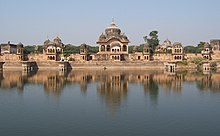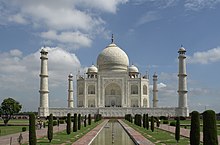Chhatri


A chhatri (from Sanskrit chhattra = "screen") is a characteristic building element of Indian architecture , especially the Hindu architecture of north-west India and the Mughal style .
description
Chhatris are small, laterally open pavilions with a dome supported by four or more pillars and mostly square, round or octagonal bases, which either stand on a base or as ornamental pavilions crown the roofs of secular, memorial or sacred buildings. In a broader sense, some larger mausoleums consisting of several domes are also referred to as chhatris.
Since the late Middle Ages, chhatris have often been erected as a cenotaph (empty grave, honorary grave) at the cremation site of wealthy or important Hindu personalities, where they - either standing alone or in groups - as simple single-dome pavilions, sometimes as more complex structures with several domes were erected.
distribution
The earliest real chhatris can be found on tombs and palaces of the Islamic rulers of northern India ; from there they came to the palace and memorial architecture of the Rajputs in Rajasthan , the former Rajputana . Mausoleums or memorial chhatris are mostly found in the vicinity of urban centers of power (e.g. Delhi , Agra , Gwalior , Orchha , Udaipur , Jaipur , Bikaner , Jaisalmer etc.) or at holy places such as Vrindavan , Varanasi and the like. a .; Such buildings are extremely rare in rural regions. Chhatris are rarely found in southern India and only appear on buildings from the 19th and early 20th centuries (e.g. on the palace of Mysore ).
Interesting is the fact that Chhatris appear regularly on mausoleums, palaces, gate buildings, drum houses ( naqqarkhanas ) etc., but only rarely on mosques - exceptions are the Friday mosques of Fatehpur Sikri and Agra , where they are unusually numerous.
history


Chhatris can be etymologically traced back to the umbrella-like crowning of a Buddhist stupa of the classical period, called Chattra (pl. Chattravali ) ; also behind standing Buddha statues of the 5th / 6th During the 19th century, such honorary umbrellas were sometimes used (some can be seen in the Museum of Sarnath ) - such umbrellas all had a sovereign and representative significance and were probably already part of the court ceremonies of pre-Buddhist rulers.
Chhatris do not appear in the oldest (preserved) free-standing Hindu temples of the 5th and 6th centuries (e.g. Gupta temple or Talagunda ). Later, similar forms reappear in Hindu architecture as so-called "umbrella domes" over mock buildings in the South Indian Dravida style (e.g. in Mamallapuram or Kanchipuram ); to some extent they can also be found in the Chalukya style of the 7th / 8th centuries. Century of Badami and the surrounding area as well as in the Chola architecture . It is unclear whether and to what extent these early buildings had an impact on the approximately 400 to 800 years later chhatris of Indo-Islamic architecture and Rajput architecture in India; Possible suggestions could also have been the pavilion-like building tops from around AD 1000 to AD 1200 in Armenian architecture - but always only appearing individually and not in groups - or the Persian-Ottoman kiosks , of which, however, only examples are known .
Chhatris do not yet appear in early buildings of Indo-Islamic architecture (see, for example, the tombs of Ghiyas-ud-din Tughluq Shah I (around 1325), of Firuz Shah Tughluq (around 1388) in Delhi or of Hoshang Shah in Mandu (around 1435)); The earliest example is the mausoleum of Mohammed Shah IV in Delhi , a ruler from the Sayyid dynasty, completed around 1445 . Another important building with chhatris is the tomb for Sher Khan Suri (around 1540) in Sasaram , Bihar . They were immediately adapted by the Mughal rulers and already appear on the founding building of the Mughal architecture , the Humayun mausoleum in Delhi - a few decades later also on various buildings in Fatehpur Sikri , the Itimad-ud-Daula mausoleum and the Taj Mahal in Agra and at the Bibi-Ka-Maqbara mausoleum near Aurangabad .
From the representative architecture of the Mughals, Chhatris found their way in the 17th century into the palace architecture of the Rajputs and from there into their memorial buildings, mostly standing on a pedestal substructure, which were collectively referred to as "Chhatris". Some of these chhatris have Bengali roofs , which sometimes apparently suited the taste of the times better.
They were also used as representative decorative elements in buildings in the Indo-Saracen style of the British colonial era (e.g. at the Victoria Memorial in Calcutta , at the Gateway of India in Bombay or at the Government Museum in Madras ).
Examples
- Fatehpur Sikri (Uttar Pradesh) (16th century): The roof of the private audience hall ( Diwan-i-Khas ) is adorned with a square, four-pillar chhatri at each corner. At the Friday mosque ( Jama Masjid ), the portal structure ( Pishtaq ) and the console roofs of the pointed arched courtyard arcades are crowned by Chhatris.
- Jaipur (Rajasthan): Moosi Maharani ki Chhatri - Kenotaphs of the queens of Jaipur.
- Jodhpur (Rajasthan): Jaswant Thada (1899), mausoleum in honor of Maharaja Jaswant Singh II, made of white marble.
- Shekhawati region (Rajasthan): The most famous examples include the beautiful Chhatri of Ram Dutt Goenka (1888) in Dundlod , as well as the Chhatris in Bissau , Parsurampura , Kirori , Jhunjhunu , Ramgarh , Mukungarh , Churu , Mahansar , and Udaipurwati .
- Indore (Madhya Pradesh): Krishnapura Chhatri; Bolia Sarkars Chhatri (1858).
- Shivpuri (Madhya Pradesh): The "Royal Chhatris", cenotaphs of the Scindia dynasty. Marble mausoleum of Madho Rao Scindia, with magnificent relief work.
Special shape

Chhaparkat is the name of a rare elongated form of Chhatri, whose elongated dome is supported by four or eight pillars; it is often found above a mosque portal or - as with the Akbar mausoleum or the neighboring tomb of his favorite wife, the Mariam's Tomb - in the middle of all four sides.
A small tower-like roof structure that ends in an opening lotus bud is called Guldasta .
See also
The main dome of St. Peter's Basilica , completed around 1590, is also surrounded by smaller accompanying domes .
literature
- Melia Belli Bose: Royal Umbrellas of Stone: Memory, Politics, and Public Identity in Rajput Funerary Art. Brill 2015, ISBN 978-90-04-30054-5 .




